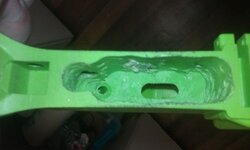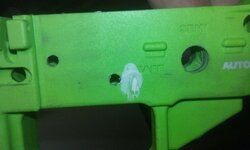Bronze Lifetime
- Messages
- 12,587
- Reactions
- 28,719
Just finished the FCG pocket on EPL#1 five minutes ago, and find that the Anderson disconnector WILL NOT let go of the hammer even with a trigger pull, or even a tool reaching in to PUSH it down. Pinholes are in jig position, though I have noticed that the half-cock notch seems to be about 1/16" from the top-front trigger corner.
Does something need to be filed or stoned down, or is it a botched lower (admittedly this one has several blemishes including a non-critical spot where I put a hole in the side)? I've tested it both in and outside using Allen wrenches as temporary FCG pins.
Does something need to be filed or stoned down, or is it a botched lower (admittedly this one has several blemishes including a non-critical spot where I put a hole in the side)? I've tested it both in and outside using Allen wrenches as temporary FCG pins.













